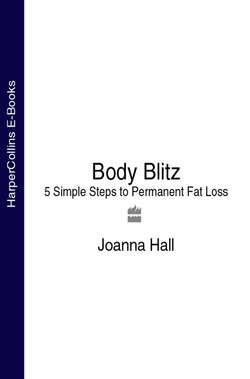Читать книгу Body Blitz: 5 Simple Steps to Permanent Fat Loss - Joanna Hall - Страница 9
GETTING YOUR DIET RIGHT
ОглавлениеThe first thing we need to look at with the Body Blitz Plan is our diet. It is very important to get the fundamentals of our diet right with the right nutrients in the right balance. A good diet includes food from each of the four nutrient food groups. These food groups are:
Carbohydrates
Proteins
Fats
Water
CARBOHYDRATES
Carbohydrates form the backbone of our diet. Fruit, vegetables, simple sugars such as biscuits and cakes, and starches such as potatoes, rice and bread are all carbohydrates. Carbohydrate-rich foods supply the body with its primary source of fuel – glucose. Glucose is a type of sugar which the body can easily use and transport – when we talk about blood sugars we are actually talking about our blood glucose levels. Glucose can be stored in the muscles as glycogen and is the main source of fuel for our working muscles, the nervous system and brain. We will be talking more about carbohydrates and starch in Step One.
PROTEINS
Proteins are essential for tissue repair, maintenance and growth. They are crucial for our health as they make up part of every cell in the body. A regular supply of protein is required in the diet to compensate for the continual loss that occurs in the body. Proteins are made up of smaller units called amino acids. Not all proteins contain all the essential amino acids required by our bodies – this is why if we are vegetarian we need to ensure that we have a variety of protein sources to ensure our bodies are getting a complete range of the necessary proteins. Protein can be divided into two groups: dairy products, which include cheese, yoghurt, eggs and non-dairy sources, which include meat, fish, pulses and beans. The important role that protein plays in repairing the body means that it is much harder for the body to store excess protein as body fat in the cells.
DIETARY FATS
Dietary fats come from a variety of sources. There are various ways of defining fats but one of the simplest is to consider fats as visible and invisible. Visible fats are, as the name suggests, foods that we can see are made of fat. Cheese, butter, oils and creams are examples of visible fats. Invisible fats are foods with a predominant fat content although we may not be aware of it: examples include coconut, avocado and egg yolks. Fats are divided into three groups: saturated, polyunsaturated and monounsaturated. Saturated fats (including trans fats) are non-essential fats because they do not play a healthy role in the body and they are associated with an increased risk of heart disease, whereas monounsaturated fats and the omega-3 and omega-6 sources of polyunsaturated fats are essential fats because they have a positive health role to play in the body. Regardless of whether they are essential or non-essential fats they all provide a rich source of energy. See Step Three for more details about dietary fats.
WATER
Water is the most overlooked nutrient in our diet – it forms about 60% of our total weight and is involved in every single chemical reaction in the body. If we don’t get enough water we are not providing the right environment for our bodies to perform effectively. It is very important to drink at least eight glasses of water a day – it really does impact how you feel and how your body works. See Step Two for more details.
…AND ALCOHOL
While alcohol is not strictly a food group in its own right it does deserve a special mention as it is such a pleasurable part of our daily lives. It is vital however that we understand the role it plays in the body and how it constrains long-term fat loss and weight management. Alcohol does supply us with a source of energy but it is not a nutrient as it is not necessary for life and it is harmful to health when consumed in excess. See Step Two for more about this.
